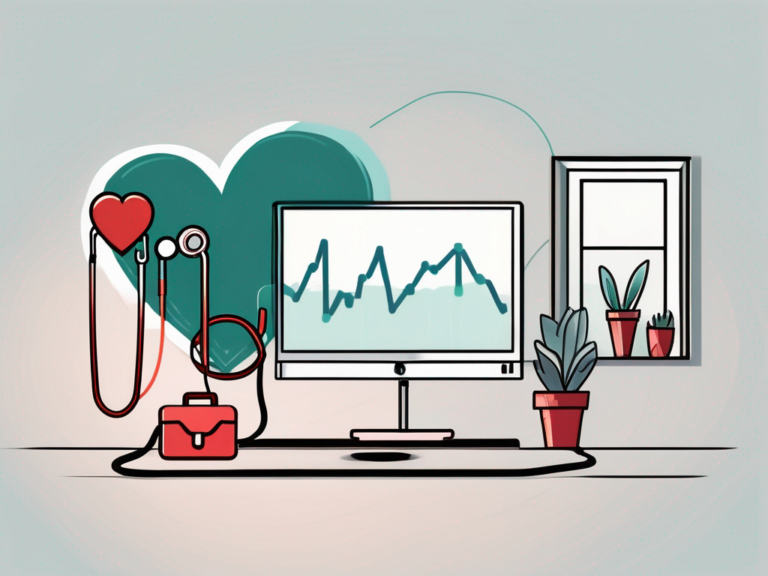How Can I Check My Heart for Blockage at Home?
Taking care of your heart is of utmost importance for leading a healthy and fulfilling life. One of the key aspects of heart health is detecting and preventing blockages in the arteries, as they can lead to serious complications such as heart attacks and strokes. In this article, we will explore various methods and tools that can help you check your heart for blockage in the comfort of your own home. So, let’s delve into the world of heart health and empower ourselves to take charge of our well-being.
Understanding Heart Blockage
Before we discuss the ways to check for heart blockage at home, it’s crucial to understand what heart blockage actually means. Heart blockage, also known as coronary artery disease, occurs when the blood vessels that supply oxygen-rich blood to the heart muscle become narrow or blocked. This happens due to the buildup of plaque, which consists of cholesterol, fat, and other substances. As the blockage worsens, it restricts the blood flow to the heart, potentially leading to cardiovascular problems.
What is Heart Blockage?
Heart blockage refers to the narrowing or complete blockage of the coronary arteries, which are responsible for carrying oxygen and nutrients to the heart muscle. When these arteries become clogged with plaque, the heart does not receive an adequate blood supply, resulting in various heart-related issues. It is crucial to detect and address heart blockage as early as possible to prevent any further damage to the heart.
Symptoms of Heart Blockage
Recognizing the symptoms of heart blockage is essential for early detection and timely intervention. Common symptoms include chest pain or discomfort, shortness of breath, fatigue, dizziness, and irregular heartbeats. However, it is important to note that not everyone experiences these symptoms, especially in the early stages of heart blockage. Hence, regular heart health monitoring becomes even more crucial.
Aside from the physical symptoms, it’s also important to be aware of the risk factors that can contribute to heart blockage. These risk factors include smoking, high blood pressure, high cholesterol levels, diabetes, obesity, a sedentary lifestyle, and a family history of heart disease. Understanding these risk factors can help individuals make informed decisions about their lifestyle choices and take preventive measures to reduce their risk of developing heart blockage.
Furthermore, it is worth noting that heart blockage can have serious consequences if left untreated. It can lead to complications such as heart attacks, heart failure, and even sudden cardiac arrest. Therefore, it is crucial to prioritize heart health and seek medical attention if any symptoms or risk factors are present.
Importance of Regular Heart Health Monitoring
Your heart health should never be taken for granted. Undetected heart blockage can gradually worsen over time, leading to severe health consequences. Regular heart health monitoring plays a pivotal role in identifying any potential issues before they escalate. Let’s take a closer look at the risks of undetected heart blockage and the benefits of regular heart health checks.
Risks of Undetected Heart Blockage
Undetected heart blockage poses a significant risk to your health and well-being. If left untreated, it can result in heart attacks, heart failure, or even sudden cardiac arrest. These conditions can be life-threatening and may require immediate medical attention. Heart blockage occurs when the blood flow to the heart muscle is restricted due to the buildup of plaque in the arteries. Over time, this plaque can harden and narrow the arteries, reducing the amount of oxygen-rich blood reaching the heart.
When the heart does not receive enough oxygen, it can lead to chest pain, shortness of breath, and fatigue. However, in some cases, heart blockage may not present any noticeable symptoms, making it even more dangerous. Regular heart health monitoring is crucial in detecting any signs of blockage and allowing healthcare professionals to intervene before it becomes a serious issue.
Benefits of Regular Heart Health Checks
Regular heart health checks offer a multitude of benefits. Firstly, they allow you to keep tabs on your heart’s condition, providing peace of mind. By regularly monitoring your heart health, you can stay informed about any changes or abnormalities that may be occurring. This knowledge empowers you to take control of your heart health and make informed decisions about your lifestyle and medical care.
Secondly, early detection of any potential blockages enables you to take immediate steps to prevent further damage. If a blockage is detected early, lifestyle modifications, medication, or medical procedures can be implemented to improve blood flow and reduce the risk of complications. By addressing the issue promptly, you can potentially avoid more invasive treatments or surgeries in the future.
Moreover, regular heart health checks can motivate you to adopt a heart-healthy lifestyle, including proper diet and exercise, to mitigate any existing risks. When you are aware of your heart’s condition and the potential consequences of neglecting it, you are more likely to prioritize your cardiovascular health. This can lead to positive changes in your daily habits, such as incorporating more fruits and vegetables into your diet, engaging in regular physical activity, and managing stress effectively.
Tools for Home Heart Check
Fortunately, there are several tools available that enable you to check your heart for blockage from the comfort of your own home. Let’s explore two of the most commonly used ones: blood pressure monitors and heart rate monitors.
Blood Pressure Monitors
Blood pressure monitors are invaluable tools for assessing your heart health. They measure the force of blood against the walls of your arteries, providing insights into whether your blood pressure is within the normal range. Elevated blood pressure is a potential risk factor for heart blockage, making regular checks essential. These monitors are easy to use and can give you a reliable indication of your cardiovascular health.
When using a blood pressure monitor, it’s important to follow the proper technique. Sit in a quiet and comfortable place, with your feet flat on the floor and your arm supported at heart level. Wrap the cuff around your upper arm, making sure it’s snug but not too tight. Then, simply press the start button and let the monitor do its job. It will inflate the cuff and gradually release the pressure, displaying your blood pressure readings on the screen. Take note of the systolic and diastolic numbers, as they indicate the pressure in your arteries during each heartbeat and between beats, respectively.
Regular monitoring of your blood pressure can help you identify any potential issues early on, allowing you to take necessary steps to maintain a healthy heart. If you notice consistently high readings, it’s important to consult with a healthcare professional for further evaluation and guidance.
Heart Rate Monitors
Heart rate monitors track your heart’s beats per minute, allowing you to monitor your heart’s activity during rest and physical exertion. By keeping an eye on your heart rate, you can observe any irregularities or changes that may indicate potential blockages. With the availability of wearable heart rate monitors, monitoring your heart health has become more convenient than ever before.
Wearable heart rate monitors come in various forms, such as wristbands, chest straps, and smartwatches. These devices use sensors to detect your pulse and provide real-time heart rate data. They can also track your heart rate variability, which is the variation in time intervals between consecutive heartbeats. This information can offer valuable insights into your overall cardiovascular fitness and stress levels.
Whether you’re going for a run, practicing yoga, or simply going about your daily activities, a heart rate monitor can help you gauge the intensity of your workouts and ensure you’re staying within a safe range. It’s important to note that individual heart rate zones vary based on factors such as age, fitness level, and overall health. By understanding your personal heart rate zones, you can optimize your exercise routine and make informed decisions about your cardiovascular health.
Non-Invasive Tests for Heart Blockage
In addition to using home monitoring devices, there are non-invasive tests that can provide valuable insights into the presence of heart blockage. Let’s explore two widely used tests: the electrocardiogram (ECG) and pulse oximetry.
When it comes to assessing the electrical activity of your heart, the electrocardiogram (ECG) takes center stage. This test, commonly conducted in hospitals or clinics, measures the electrical signals generated by your heart as it beats. However, advancements in technology have made it possible for individuals to perform an ECG test in the comfort of their own homes. Yes, you read that right! There are now portable ECG devices available for home use. These compact and user-friendly devices allow you to regularly assess your heart’s electrical patterns and share the results with your healthcare provider for further evaluation. With an at-home ECG, you can take an active role in monitoring your heart health and potentially detect any abnormalities or signs of heart blockage.
Now, let’s shift our focus to pulse oximetry, another non-invasive test that can provide valuable insights into your cardiovascular health. Pulse oximetry measures the oxygen saturation in your blood, giving you a glimpse into how well your heart is pumping oxygen to the rest of your body. This test involves placing a small device, called a pulse oximeter, on your finger or earlobe. The pulse oximeter uses light to determine the amount of oxygen in your blood by measuring the changes in light absorption caused by oxygenated and deoxygenated blood. By monitoring your blood oxygen levels, pulse oximetry can alert you to any potential issues and help you take proactive steps to maintain a healthy cardiovascular system.
So, whether you opt for an at-home ECG or pulse oximetry, these non-invasive tests provide valuable information about your heart’s electrical activity and oxygen levels. By incorporating these tests into your routine, you can stay proactive in monitoring your heart health and potentially detect any signs of heart blockage early on. Remember, knowledge is power when it comes to taking care of your heart!
Lifestyle Changes to Prevent Heart Blockage
Preventing heart blockage goes hand in hand with adopting a heart-healthy lifestyle. By making conscious choices and committing to positive changes, you can significantly reduce your risk of heart problems.
One important aspect of maintaining a healthy heart is managing stress. Chronic stress can contribute to the development of heart disease by increasing blood pressure and promoting inflammation. Finding healthy ways to cope with stress, such as practicing relaxation techniques like deep breathing or meditation, can help protect your heart.
Healthy Eating Habits
A well-balanced diet is essential for maintaining a healthy heart. Focus on incorporating fresh fruits, vegetables, whole grains, lean proteins, and healthy fats into your meals. Limit your intake of processed foods, saturated fats, and sugary beverages. By nourishing your body with the right nutrients, you are giving your heart the support it needs to stay strong and free from blockages.
In addition to choosing heart-healthy foods, it’s important to pay attention to portion sizes. Overeating can lead to weight gain and increase the strain on your heart. Practice mindful eating by listening to your body’s hunger and fullness cues, and aim to eat until you are satisfied, not overly stuffed.
Regular Exercise and its Benefits
Physical activity is a cornerstone of heart health. Engaging in regular exercise helps improve blood circulation, strengthens your heart muscle, and keeps your arteries flexible and healthy. Aim for at least 150 minutes of moderate-intensity aerobic exercise or 75 minutes of vigorous activity per week. Find activities that you enjoy, such as walking, cycling, swimming, or dancing, and make them a regular part of your routine.
In addition to the physical benefits, exercise also has a positive impact on mental health. Regular physical activity can help reduce symptoms of depression and anxiety, improve sleep quality, and boost overall mood and well-being. By incorporating exercise into your daily life, you are not only taking care of your heart but also nurturing your mental and emotional well-being.
When to Seek Medical Help
While home monitoring and preventive measures are beneficial, it is important to know when to seek medical help. Recognizing the more serious symptoms of heart blockage is crucial for prompt intervention.
Recognizing Serious Symptoms
If you experience persistent chest pain or pressure, sudden shortness of breath, severe dizziness, or fainting, it is essential to seek immediate medical assistance. These symptoms may indicate an acute cardiac event and require urgent medical attention. Never ignore any signs that could potentially be life-threatening.
Importance of Regular Medical Check-ups
Regular medical check-ups are vital for monitoring your overall health, including your heart health. Your healthcare provider can conduct comprehensive evaluations, perform tests, and offer personalized advice to keep your heart in optimal condition. By scheduling regular check-ups, you can address any concerns or detect potential problems early on.
During these check-ups, your healthcare provider will assess your blood pressure, cholesterol levels, and other key indicators of heart health. They may also recommend additional tests, such as an electrocardiogram (ECG) or stress test, to evaluate your heart’s function and identify any potential blockages.
Furthermore, regular medical check-ups provide an opportunity for you to discuss your lifestyle habits with your healthcare provider. They can offer guidance on maintaining a heart-healthy diet, engaging in regular physical activity, managing stress, and avoiding tobacco and excessive alcohol consumption. These lifestyle modifications can significantly reduce the risk of heart blockage and other cardiovascular diseases.
In conclusion, prioritizing your heart health and proactively checking for blockages at home can make a world of difference in maintaining a healthy cardiovascular system. By understanding heart blockage, using home monitoring tools, and making lifestyle changes, you empower yourself to take control of your well-being. Remember, your heart is the engine that keeps you going, so let’s treat it with the care it deserves.






